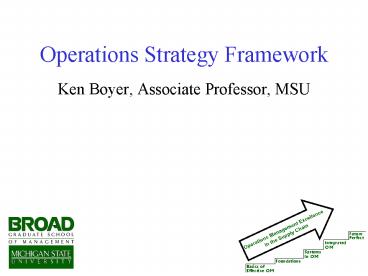Operations Strategy Framework - PowerPoint PPT Presentation
1 / 19
Title:
Operations Strategy Framework
Description:
Winners: separate the product/service from the pack. ... of STRUCTURAL and INFRASTRUCTURAL decisions with a single, over-riding objective ... – PowerPoint PPT presentation
Number of Views:233
Avg rating:3.0/5.0
Title: Operations Strategy Framework
1
Operations Strategy Framework
- Ken Boyer, Associate Professor, MSU
2
Operations Strategy Framework
- Operations is a broader term than manufacturing.
Much of manufacturing advantage comes from
non-manufacturing activities such as new product
development, supplier management, matching
operations with marketing, etc.
3
Learning Objectives
- Understand the importance of setting clear
competitive priorities - Learn how to match priorities with operating
decisions AND strategies of other functional
areas. - Recognize the need to promote strategic
consensus. - Appreciate the opportunities associated with
technological proactiveness. - Realize the need to build infrastructural
capabilities.
4
Operations Strategy Process
Decision Areas
Competitive Priorities
Business Strategy
External Factors
5
Competitive Priorities
6
Decision Areas
Capacity Facilities Technology Vertical
Integration/Sourcing
Workforce Quality Production Planning Organization
7
Competitive Priorities .... Order
Winners/Qualifiers
- Qualifiers Get a product into the market and
keep it there, but dont win the order - Winners separate the product/service from the
pack. Things that actually win the order or
provide a distinctive competence
8
- Many companies fail to appreciate that the MOST
CRITICAL orders are the ones to which the answer
says ......
NO!!!
9
Changes in Operations Strategy.... An Example
Ford (1915)
Pre-Ford (1900)
10
Henry Ford and the Model T
- From 1909 to 1923 Ford Model T improved in price
by a factor of 4 - Primary competitive priority (order winner) was
clearly COST - Fords competitive priorities gave rise to a
coherent set of STRUCTURAL and INFRASTRUCTURAL
decisions with a single, over-riding objective
11
Ford Motor Co. Methods Used
- Product Stability
- Capital Equipment Specialization
- Process Rationalization
- Scale Economies
- Material Specialization
- Labor Specialization
12
Too much of a good thing .....
- By 1920 Ford was SO SUCCESSFUL and TOO RIGID ....
- Henrys motto was You can have it in any color
.... - .... So long as it is BLACK!!!
13
Time for A NEW Strategy!
- GM could not beat Ford at COST, so Sloan decided
to beat them with FLEXIBILITY. - More models, more colors
- Ford became so inflexible, that in 1926 had to
shutdown for one year to retool for Model A - Ford fell from No. 1 automaker .... and has never
recovered.
14
Ford (1915)
Pre-Ford (1900)
GM (1930)
15
Another Example ....
- Anybody ever heard of Mostronics Calculators?
- In 1970s they were a leading manufacturer, BUT
Texas Instruments aggressively reduced prices to
fit experience curve - Drove Mostronics out of business because they
could not compete based on cost.
16
An Alternative Strategy
- Hewlett Packard remained in the business by
emphasizing QUALITY and FLEXIBILITY rather than
low price. - Similar example IBM vs. Compaq or Dell computers
(1st generation), Packard Bell or Gateway (2nd
generation)
17
Trade-off Model of Competitive Priorities
- This is the traditional model
- Companies can only emphasize a single priority at
a time. - i.e. COST ....
- or ................. FLEXIBILITY or
- QUALITY
- or ............................................
DELIVERY
18
Cumulative or Sand-cone Model
- Companies can simultaneously compete on several
competitive priorities. - Possible due to advanced manufacturing
technologies (CIM FMS)
19
Operations Reactive or Proactive?3 Dimensions
of Proactivity
- Manufacturing Involvement
- Operations is centrally involved in formulating
business strategy as well as other functional
areas - Technical Assertiveness (Structure)
- Operations makes efforts to anticipate the
potential of new technologies - Capability Building (Infrastructure)
- Operations pursues long-range programs in order
to acquire capabilities in advance of needs.































